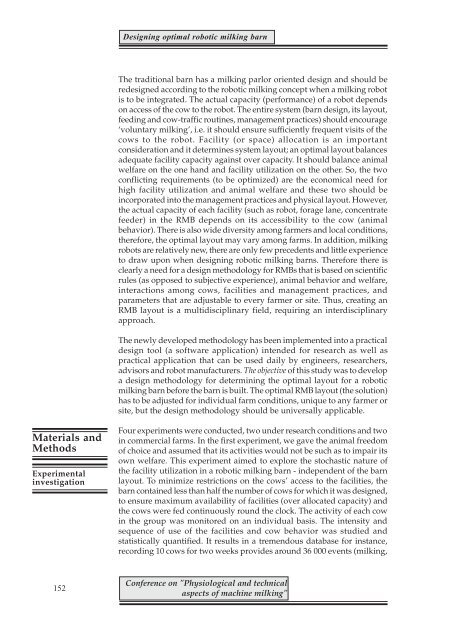ICAR Technical Series no. 7 - Nitra Proc.
ICAR Technical Series no. 7 - Nitra Proc.
ICAR Technical Series no. 7 - Nitra Proc.
- No tags were found...
You also want an ePaper? Increase the reach of your titles
YUMPU automatically turns print PDFs into web optimized ePapers that Google loves.
Designing optimal robotic milking barnThe traditional barn has a milking parlor oriented design and should beredesigned according to the robotic milking concept when a milking robotis to be integrated. The actual capacity (performance) of a robot dependson access of the cow to the robot. The entire system (barn design, its layout,feeding and cow-traffic routines, management practices) should encourage‘voluntary milking’, i.e. it should ensure sufficiently frequent visits of thecows to the robot. Facility (or space) allocation is an importantconsideration and it determines system layout; an optimal layout balancesadequate facility capacity against over capacity. It should balance animalwelfare on the one hand and facility utilization on the other. So, the twoconflicting requirements (to be optimized) are the eco<strong>no</strong>mical need forhigh facility utilization and animal welfare and these two should beincorporated into the management practices and physical layout. However,the actual capacity of each facility (such as robot, forage lane, concentratefeeder) in the RMB depends on its accessibility to the cow (animalbehavior). There is also wide diversity among farmers and local conditions,therefore, the optimal layout may vary among farms. In addition, milkingrobots are relatively new, there are only few precedents and little experienceto draw upon when designing robotic milking barns. Therefore there isclearly a need for a design methodology for RMBs that is based on scientificrules (as opposed to subjective experience), animal behavior and welfare,interactions among cows, facilities and management practices, andparameters that are adjustable to every farmer or site. Thus, creating anRMB layout is a multidisciplinary field, requiring an interdisciplinaryapproach.The newly developed methodology has been implemented into a practicaldesign tool (a software application) intended for research as well aspractical application that can be used daily by engineers, researchers,advisors and robot manufacturers. The objective of this study was to developa design methodology for determining the optimal layout for a roboticmilking barn before the barn is built. The optimal RMB layout (the solution)has to be adjusted for individual farm conditions, unique to any farmer orsite, but the design methodology should be universally applicable.Materials andMethodsExperimentalinvestigationFour experiments were conducted, two under research conditions and twoin commercial farms. In the first experiment, we gave the animal freedomof choice and assumed that its activities would <strong>no</strong>t be such as to impair itsown welfare. This experiment aimed to explore the stochastic nature ofthe facility utilization in a robotic milking barn - independent of the barnlayout. To minimize restrictions on the cows’ access to the facilities, thebarn contained less than half the number of cows for which it was designed,to ensure maximum availability of facilities (over allocated capacity) andthe cows were fed continuously round the clock. The activity of each cowin the group was monitored on an individual basis. The intensity andsequence of use of the facilities and cow behavior was studied andstatistically quantified. It results in a tremendous database for instance,recording 10 cows for two weeks provides around 36 000 events (milking,152Conference on "Physiological and technicalaspects of machine milking"
















